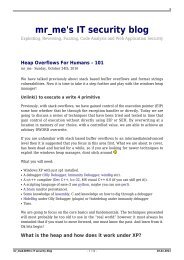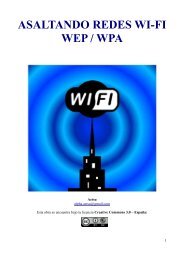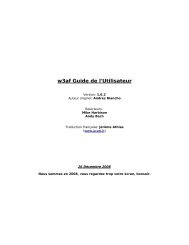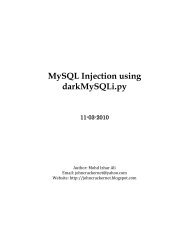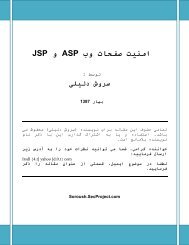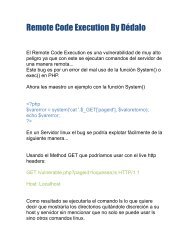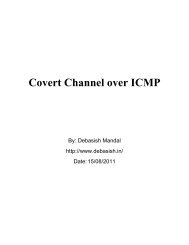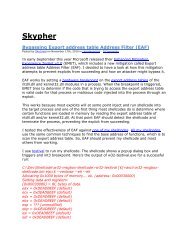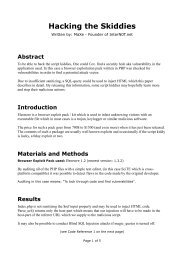Forensic analysis of iPhone backups - Exploit Database
Forensic analysis of iPhone backups - Exploit Database
Forensic analysis of iPhone backups - Exploit Database
Create successful ePaper yourself
Turn your PDF publications into a flip-book with our unique Google optimized e-Paper software.
tools to recover the deleted files from the system hard disk. It is easy to recover the deleted files from<br />
the computer when compared with <strong>iPhone</strong>.<br />
The <strong>iPhone</strong> stores a lot <strong>of</strong> user data in the backup files. The following table list out the common<br />
sources <strong>of</strong> potential evidence that can be analyzed in an investigation.<br />
File Name<br />
AddressBook.sqlitedb<br />
AddressBookImages.sqlitedb<br />
Calendar.sqlitedb<br />
Call_history.db<br />
Sms.db<br />
Voicemail.db<br />
Sfari/Bookmarks.db<br />
Safari/History.plist<br />
Notes.sqlite<br />
Maps/History.plist<br />
Maps/Bookmarks.plist<br />
consolidated.db<br />
En_GB-dynamic-text.dat<br />
com.apple.accountsettings.plist<br />
com.apple.network.identification.plist<br />
Description<br />
Contact information and personal data like name, email address,<br />
birthday, organization, etc...<br />
Images associated with saved contacts<br />
Calendar details and events information<br />
Incoming and outgoing call logs including phone numbers and<br />
time stamps<br />
Text and multimedia messages along with their timestamps<br />
Voicemail messages<br />
Saved URL addresses<br />
User’s internet browsing history<br />
Apple Notes application data<br />
It keeps track <strong>of</strong> location searches<br />
Saved location searches<br />
Stores GPS tracking data<br />
Keyboard cache<br />
Maintains data about all email accounts that are configured on the<br />
Apple Email application<br />
Wireless network data including IP address, router IP address,<br />
SSID and timestamps<br />
(Table 7)<br />
Along with the files listed in the above table, the <strong>iPhone</strong> backup also contains third party application<br />
files. Sensitive information stored in the third party application files may also provide possible<br />
evidence for the investigation.<br />
Example: Facebook and LinkedIn <strong>iPhone</strong> applications store the authentication tokens and cookie<br />
values in plist files on the device. During backup, iTunes copies the plist files on the device to the<br />
backup folder. In such cases, analyzing the backup files gives access to the authentication tokens<br />
which in turn allows to log into the application without supplying the username and password.<br />
More details about Facebook plist hijacking are documented at scoopz blog.<br />
During an <strong>iPhone</strong> backup, iTunes only stores the existing files to the backup. So it is not possible to<br />
recover the deleted files on the <strong>iPhone</strong> from <strong>backups</strong>. Though it is not possible to recover the deleted<br />
<strong>iPhone</strong> data, forensic examiners prefer analyzing the <strong>backups</strong> to collect the evidence as it does not<br />
compromise the contents on a live device.



